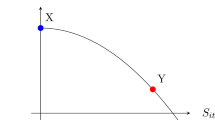Abstract
We present a computational model which predicts people’s switching behaviour in repeated gambling scenarios such as the Iowa Gambling Task. This Utility-Caution model suggests that people’s tendency to switch away from an option is due to a utility factor which reflects the probability and the amount of losses experienced compared to gains, and a caution factor which describes the number of choices made consecutively in that option. Using a novel next-choice-prediction method, the Utility-Caution model was tested using two sets of data on the performance of participants in the Iowa Gambling Task. The model produced significantly more accurate predictions of people’s choices than the previous Bayesian expected-utility model and expectancy-valence model.
Similar content being viewed by others
References
Arrow KJ (1965) Aspects of the theory of risk-bearing. Hahnsson Foundation, Helsinki
Barron G, Erev I (2003) Small feedback-based decisions and their limited correspondence to description-based decisions. J Behav Decis Mak 16: 215–233
Bechara A, Damasio H, Tranel D, Anderson SW (1994) Insensitivity to future consequences following damage to human prefrontal cortex. Cognition 50: 7–15
Bernoulli D (1967) Exposition of a new theory on the measurement of risk. Gregg Press, England (Original work published in 1738)
Bishara AJ, Pleskac TJ, Fridber DJ, Yechiam E, Lucas J, Busemeyer JR, Fin PR, Stout JC (2006) Models of risky decision-making in Marijuana and stimulant users. Unpublished Manuscript
Busemeyer JR, Stout JC (2002) A contribution of cognitive decision models to clinical assessment. Psychol Assess 14: 253–262
Coombs CH, Meyer DE (1969) Risk-preference in coin-toss games. J Math Psychol 6: 514–527
Even-Dar E, Mannor S, Mansour Y (2002) PAC bounds for multi-armed Bandit and Markov decision processes. In: Fifteenth annual conference on computational learning theory (COLT), pp 255–270
Fum D, Stocco A (2004) Memory emotion and rationality: an ACT-R interpretation for gambling task results. In: Schunn CD, Lovett MC, Lebiere C, Munro P (eds) Proceedings of the sixth international conference on cognitive modelling. Lawrence Erlbaum, Mahwah, NJ, pp 211–216
Gigerenzer G (2007) Gut feelings: the intelligence of the unconscious. Penguin Books Ltd, London
Kahn BE, Ratner RK, Kahneman D (1997) Patterns of hedonic consumption over time. Mark Lett 8: 85–96
Kahneman D, Tversky A (1972) Subjective probability: a judgment of representativeness. Cogn Psychol 3: 430–454
Kahneman D, Tversky A (1979) Prospect theory: an analysis of decisions under risk. Econometrica 47: 263–291
Kahneman D, Slovic P, Tversky A (1982) Judgment under uncertainty: heuristics and biases. Cambridge University Press, Cambridge, England
Keren G, Wagenaar WA (1987) Violation of utility theory in unique and repeated gambles. J Exp Psychol Learn Mem Cogn 13: 387–391
Levine DS, Mills B, Estrada S (2005) Modeling emotional influences on human decision making under risk. In: Proceedings of internal joint conference on neural networks. IEEE Press, Montreal, pp 1657–1662
Mas-Collel A, Whinston M, Green JR (1995) Microeconomic theory. Oxford University Press, New York
Ratner RK, Herbst KC (2005) When good decisions have bad outcomes: the impact of affect on switching behavior. Organ Behav Human Decis Process 96: 23–37
Ratner RK, Kahn BE, Kahneman D (1999) Choosing less-preferred experiences for the sake of variety. J Consumer Res 26: 1–15
Robbins H (1952) Some aspects of the sequential design of experiments. Bull Am Math Soc 55: 527–535
Simon HA (1982) Models of bounded rationality. MIT Press, Cambridge
Stocco A, Fum D (2006) Memory and emotion in the gambling task: the case for independent processes. In: R Sun, N Miyake (eds) Proceedings of the 28th annual conference of the cognitive science society. Lawrence Erlbaum Associates, Mahwah, NJ, pp 2192–2197
Author information
Authors and Affiliations
Corresponding author
Rights and permissions
About this article
Cite this article
Zhao, J., Costello, F.J. Computational modelling of switching behaviour in repeated gambles. Artif Intell Rev 27, 209–222 (2007). https://doi.org/10.1007/s10462-008-9083-4
Published:
Issue Date:
DOI: https://doi.org/10.1007/s10462-008-9083-4




